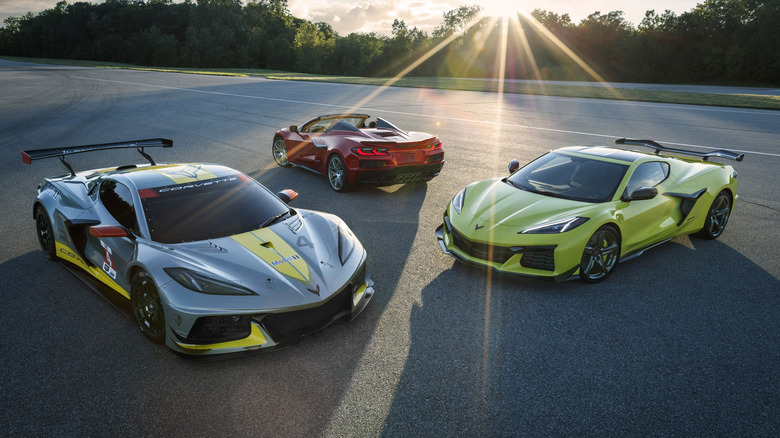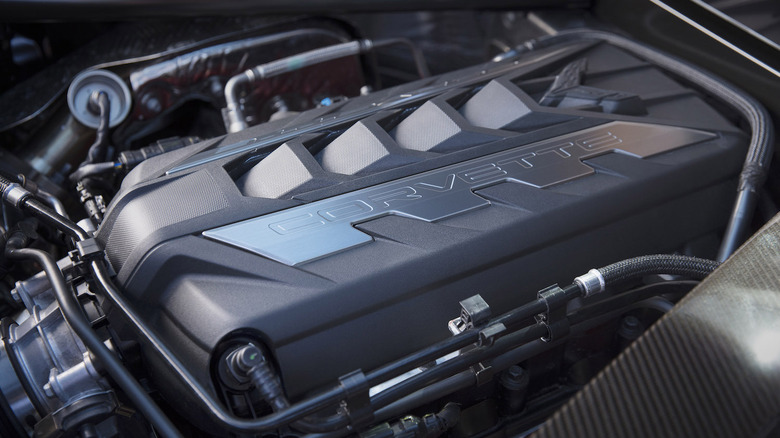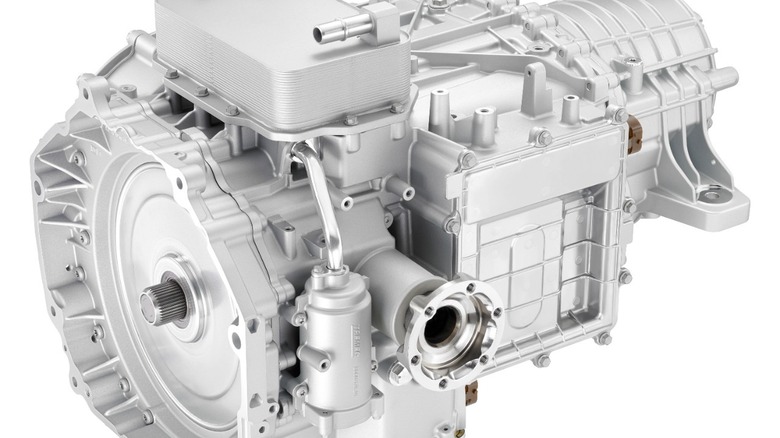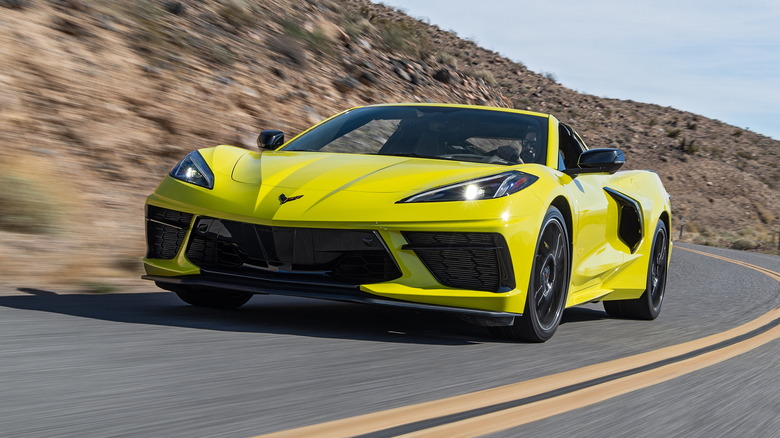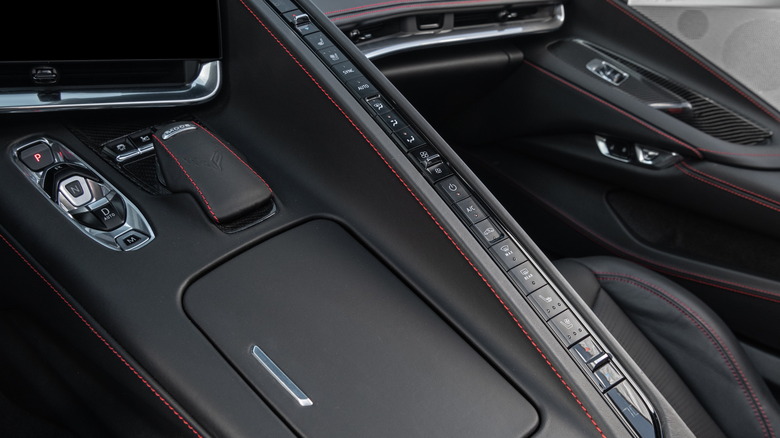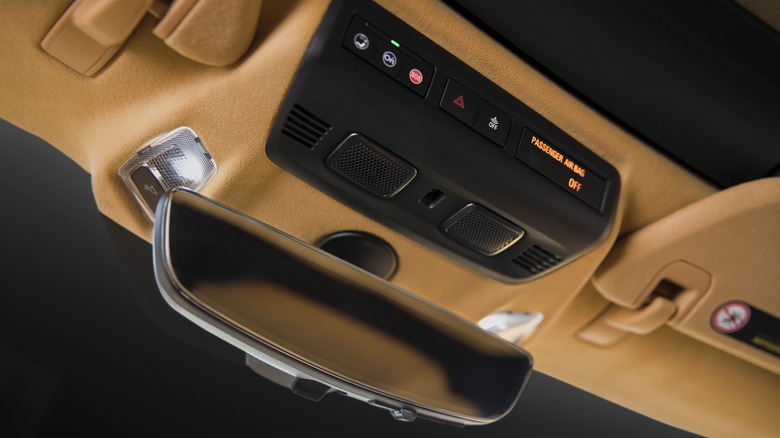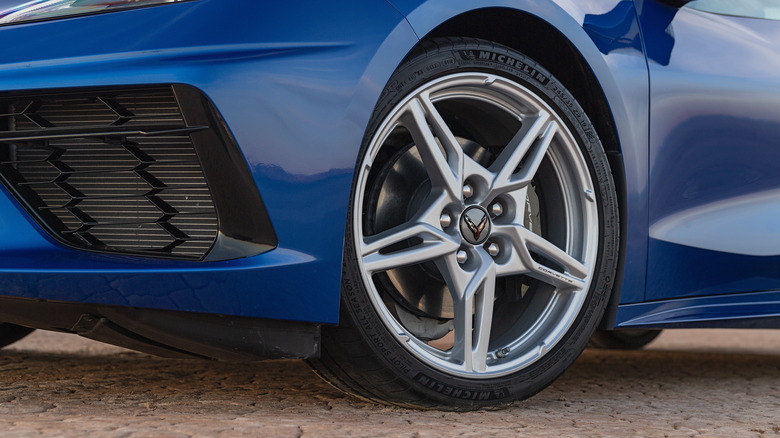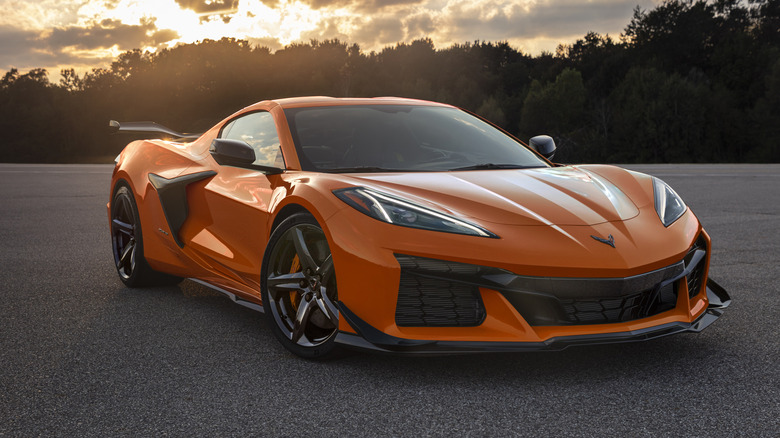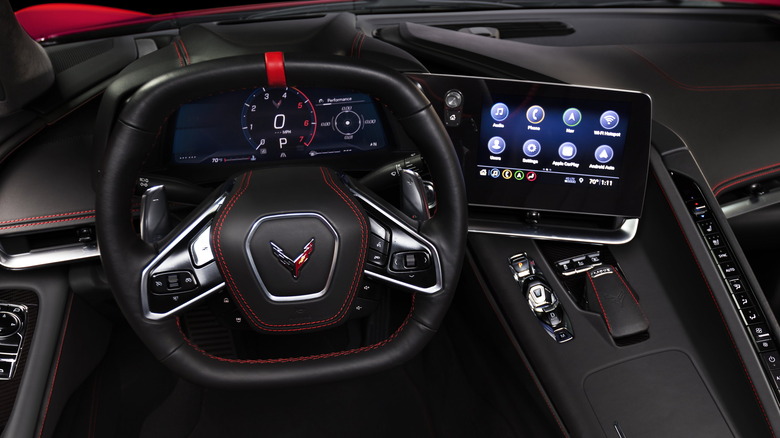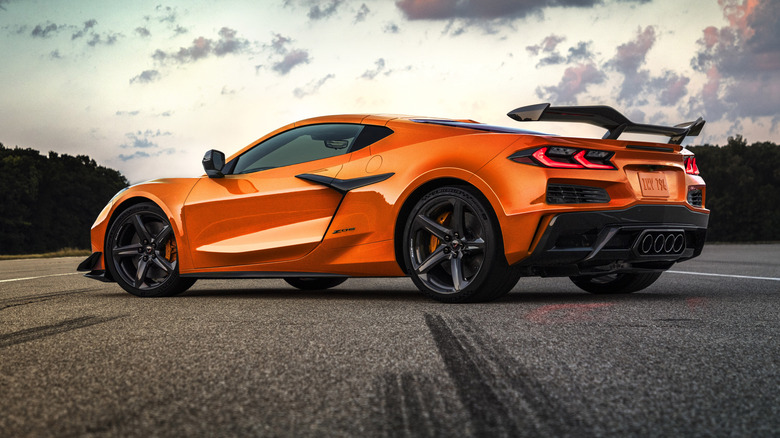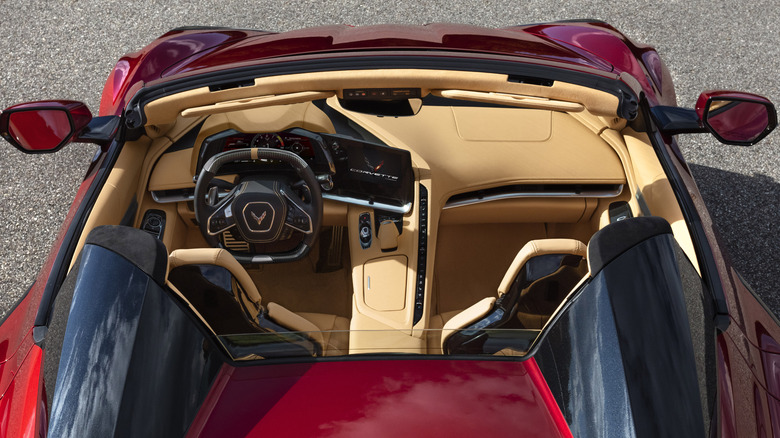The 10 Coolest Features Of The 2022 Chevrolet Corvette
The Chevrolet Corvette sits at the top of the range of one of America's best-selling brands of automobiles. The Corvette started life in 1953 as a sporty coupe to compete with the stylish European cars being imported, according to CNet. While it launched as a rather modest roadster with an underpowered 6-cylinder engine, the model quickly became a tire-roasting machine with V8 engines of ever-growing sizes being installed until the Corvette was, for a time, the undisputed American king of speed.
Staring in 2020 and continuing into the 2022 model year, the Corvette is now a mid-engined fire-breathing beast of a car. The new design takes cues from the styling of the previous generation and translates them into an all-new form to integrate the new engine position beautifully. However, modern cars are so much more than just an engine and a few wheels as modern technology has afforded us the ability to fill our vehicles with a dizzying array of bells and whistles. Chevrolet is keen to draw in buyers of more expensive cars by offering the Corvette with the comfort and performance those buyers desire while upping the ante with a bevy of extras. The 2022 Corvette's list of standard and optional features is fairly long, but 10 stand out among them.
LT2 V8 engine
Ever since Chevrolet upgraded the Corvette to a V8 from its original Blue Flame inline-six, it has been all about those eight cylinders and 16 pushrods. Corvette engines have been continuously upgraded over the years, but the basic setup has remained the same...until now. The C8 Corvette introduced in 2020 moved the placement of the engine from the traditional position in the front of the car to behind the driver and passenger. This was a revolutionary shift for an American auto company, as the mid-engine sports car has traditionally been the realm of European automakers.
Remarkably, even with the change of engine location, Chevrolet has retained a pushrod V8 for its latest Vette, but that does not mean it cannot keep up with its foreign counterparts. While the imported cars usually utilize overhead cams and multiple valves per cylinder, the 6.2-liter GM LT2 V8 still relies on pushrods and two valves per cylinder just like every Corvette since the mid-'50s. However, this newest iteration of the Corvette V8 is loaded up with technology and manages to push out 495 horsepower without the use of forced induction. It is a genuinely impressive bit of engineering that shows American ingenuity is still alive and well (via GM Authority).
Dual-clutch transmission
Another breakaway from previous generations of Corvette lies in the transmission. Starting in 2020, Corvettes are no longer offered with a manual transmission and the usual torque converter-driven automatic has been ditched for an all-new dual-clutch system developed by Tremec. The choice of the DCT is notable as this is a technology born from F1 racing and adopted widely among very high-end European carmakers; it represents yet another way Chevrolet is finding ways to compete both on the track and in the showroom.
In order to bring the C8 Corvette up to a competitive level with its mid-engine setup, a transmission that could handle the torque and deliver it quickly was needed. The result of the work is the Tremec TR-9080 8-speed transmission. Auto Evolution goes into detail about this transmission, noting some of its highlights being super-fast shifts of less than 100 milliseconds and its powerful 32-bit controller.
MSRP
For years it has been a given that to get a car with substantial horsepower with an engine in the middle and sharp, aggressive styling, the cost would be out of reach for almost everyone. Only the most successful doctors, lawyers, and those with a lucky family situation could afford such extravagance. Yet, Chevrolet has turned that notion on its head with the Corvette.
Kelly Blue Book reveals the base model Corvette starts at $60,900 and can be optioned out to $80,000 or more. Base models come standard with the LT2 V8 with 490 horsepower and the 8-speed Tremec DCT. We reported that Chevrolet originally wanted to release the 2020 Corvette at under $60,000 and has not gone up much since. For comparison, a Lamborghini Huracan starts at more than $200,000 and the Audi R8 starts at more than $150,000. These cars may be more powerful and equipped with a few more features or luxury options, but they are not significantly faster on the track. This means the 2022 Corvette is the absolute best value for money in mid-engined sports cars. While beauty is in the eye of the beholder, most people with decent vision will agree the Corvette is an aggressive and attractive car.
Center stack controls
The 2022 Corvette is highly driver-focused. The interior and all its accouterments are clearly designed to be easily accessed by the driver, making it simple to keep attention on the road ahead. The many details included in the center portion of the dash and running down to the center console is among the coolest parts of the interior. We found the interior to be rather impressive upon the initial release of the first C8 Corvette.
The C8 Corvette interior could be described as a cockpit as much as anything else. Everything is oriented toward the driver and within easy reach and, as reviewed by Motor Trend, is well-appointed toward the luxury end of the scale. The center control stack and console are integrated into a single, sweeping piece that starts at the gauge cluster, terminates between the seats, and is rather impressive. The best parts are the line of buttons running down the center of the car with various functions for climate control, audio, and seats. It is reminiscent of the lines of toggles and buttons in an airplane. Furthermore, the infotainment screen is oriented similar to a flight control panel but is chock full of functions for standard stuff like audio control along with performance settings and camera layouts. For anyone who loves aviation and fancies the thought of having their own fighter jet, the Corvette is a cool alternative.
Rearview mirror
When driving an ultra-fast car, most of the attention is on going forward, rapidly. But some of the most challenging driving in many fast cars comes in the parking lots. Backing up a car like a Countach, for example, can be a tricky maneuver, as demonstrated by Chris Harris on The Drive. Finding ways to help drivers back up is an often overlooked but much-appreciated detail manufacturers can focus on.
Chevrolet has found a solution to this rear visibility problem with an elegant solution provided by technology. The rearview mirror in the Corvette is a standard electrochromic mirror when sitting idle. However, with a simple press of a button, the mirror becomes an electronic display for a rear-mounted camera built into the roof of the car as shown in this video from GM. And not only can you see behind the car completely free of obstructions, but the screen can also be zoomed and moved to get a better view of what's back there. Driving a Corvette in congested city centers and finding parking in tight downtown garages is just a little bit easier on the C8 Corvette.
Curb-view camera
Low-slung sports are notoriously troublesome in parking lots, as are the tight and often uneven driving surfaces in city centers. Drivers of such cars are forever fretting about, scraping their front spoilers, air dams, and bumpers on ramps, speed bumps, and cobblestones. Chevrolet addressed this issue with some ingenious solutions.
The front of the C8 Corvette includes a camera that looks directly in front of the car. In Chevrolet's Corvette Academy, the driver assistance features go over all the aids for the car, including the three cameras on the front of the vehicle. By pressing a dedicated button, the front cameras can be used to show an on-screen top-down view of obstacles immediately in front of the car, as well as the option to include side views to help in especially tricky situations. Even though the Corvette is substantially cheaper than its Italian rivals, owners will still want to take great care in avoiding damage to the delicate body, making these aids a fantastic addition to the car.
Front lift
Front lift is an option for the Corvette, according to the manufacturer; it features a dedicated button that, when pressed, hydraulically raises the front end of the car up to 2 inches in 30 seconds. This makes it extremely easy and fast to use, which is important in a congested downtown parking area. The best part of this feature is that it can remember up to 1,000 locations by GPS. The Corvette can automatically raise up when needed in places where you often drive, such as a parking lot at work. The car lowers itself back down after shutdown or once 24 mph has been reached.
Chevrolet says it included this mashed on feedback from owners. Corvette owners are a passionate bunch, none of them appreciate getting scrapes every time they pull up in the driveway, and just 2 inches can provide a surprising amount of protection. Combined with the front cameras, there should no longer be any excuse for getting scrapes on the front splitter.
Perfromance data recorder
The Corvette uses its onboard cameras and engine computer to offer another truly useful feature for both on and off the track. Chevrolet knows its car is a fast machine and that buyers intend to drive it at high speeds. The automaker also knows many drivers will choose to use the vehicle on the track either for leisure or sport. For those who wish to use past performance to improve future performance, the data recorder can help do just that.
GM Authority explains how to use the system, which offers a few different modes. Using engine telemetry, drivers can get video playback accompanied by engine performance with speed and braking information all recorded to an SD card. Not only is this a handy tool for amateur and even professional drivers, but it can also be used as a dashcam for normal everyday driving. Furthermore, the feature can be used to check how the car is kept by a service center or valet. For example, Motor Biscuit reports that a driver allegedly busted GM techs at a dealer for not only racing a Dodge Charger in his Corvette but also racing it at speeds up to 148 mph. Without the PDR, this activity would have gone unnoticed and the tech's alleged dangerous driving would have possibly never been exposed.
Z51 package
Perhaps a performance package is not a feature. In reality, it is several features and definitely deserves a mention as it takes an already great car and somehow improves upon it. The Z51 package is an optional upgrade that adds about $6,000 to the MSRP and comes with both mechanical and appearance additions.
Most notable are the performance additions, including beefier brakes, electronic limited-slip differential, performance traction management, and a dual-mode exhaust that adds 5 horsepower, according to Car and Driver. Also aiding in performance are the appearance additions of a rear spoiler and front splitter that not only help achieve a more aggressive look but add downforce and grip. The Z51 also comes with better tires, specifically the Michelin Pilot Sport 4S ZP summer tires. These provide a better grip than the all-season tires standard on other Corvettes, and that pairs with revised suspension tuning to keep the already well-sorted ride even more firmly planted through the bends.
Head-up display
General Motors pioneered the use of head-up displays (HUDs) by being the first auto manufacturer to include them in a regular production model. SAE reports that the 1988 Oldsmobile Cutlass Supreme was the first car to offer this option, which has since been applied to models throughout the GM lineup. The first Corvette to offer HUD was the C5 in 1999, according to Kelley Blue Book. The technology behind it has changed but the basic function has remained the same.
When it comes to the 2022 Corvette, the HUD is versatile and dynamic. Most of the functions of the digital gauge cluster can be transmitted through the HUD. Autoblog explains that the Corvette gauge display modes are Tour, Sport, and Track. Each mode changes the info displayed and what gets prominence. For example, Track mode presents the tachometer most prominently with the speed secondary. These same selections can be transmitted through the HUD. Ultimately, the Track mode HUD is the most useful as it allows drivers who are pushing the car to its limits to keep their eyes glued straight ahead on the pavement with no excuse for looking away.
